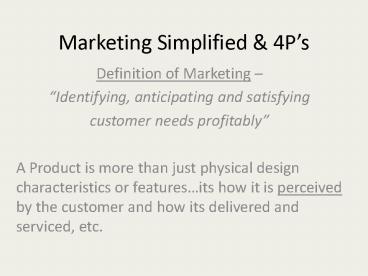Marketing Simplified - PowerPoint PPT Presentation
1 / 18
Title:
Marketing Simplified
Description:
So, a cruise, tax consulting and babysitting are products just like a six-pack ... because it deals with how potential buyers see (perceive) the product. ... – PowerPoint PPT presentation
Number of Views:81
Avg rating:3.0/5.0
Title: Marketing Simplified
1
Marketing Simplified 4Ps
- Definition of Marketing
- Identifying, anticipating and satisfying
- customer needs profitably
- A Product is more than just physical design
characteristics or featuresits how it is
perceived by the customer and how its delivered
and serviced, etc.
2
5 Principles of Marketing
- find out what your target market needs, and then
(working with them) conceive a product to fulfill
those needs. - define who your customers are in detail (target
market of people who write your check). - develop a message that speaks directly to their
needs. Offer clear benefits, not features . This
is the VALUE PROPOSITION - position yourself in the mind of the customer
where they already go and search. - make your products and services easy to adopt and
obtain by your target customer.
3
Product includes services as well as physical
things. So, a cruise, tax consulting and
babysitting are products just like a six-pack of
soft drinks and a plaid shirt.
- In fact all products are services because they
all do something for the customer. - To conceive your product, you have to consider
all elements which, combined, satisfy your
customer's needs -BETTER than your competitor.
(product includes packaging and warranties, as
well as features)
4
Research the competitions products
- You need to know what makes your product better
than your competitors' to offer a good value
proposition - Lead user studies
- You can buy their products and try them out
- Put yourself in your customer's shoes (use
surveys or focus groups) to identify what they
like (and hate) in competitors products. - Surf! read reviews of products
5
Price
- Two things to consider
- Willingness to Pay
- How much will your product save your customer?
- How much does competition charge?
- What is your cost?
6
Price
What makes a customer willing to pay more for
your product than for the competitions?
Benefits (things that are valuable to them)
you offer that they dont
- Two things to consider
- Willingness to Pay
- How much will your product save your customer?
- How much does competition charge?
- What is your cost?
7
Important Points when setting price
- Target Market who is the customer (actually
writes the check)? Who influences this person?
What is customers willingness to pay? - Business Model - describes the opportunity and
how seller can make money. It tells who pays
(above), how much, how often and why. It includes
the Value proposition (see below) - Value Proposition (offer to the customer)- tells
customers WHY they should give up the price to
obtain your offering. It also tells them why it
is valuable to deal with you rather than
competitors - Demand Elasticity - Will customers in your market
switch to your competitors product over a small
change in price?
8
Value Proposition an offering to the customer
that is worth more than the price he must pay.
Willingness to pay, W
W-P Value? Customer Happiness
Look for Business Models (opportunities) where
W-C is big! This lets you give the customer a
big W-PValue and you can still get a big
P-CProfit
Price, P
P-C Profit
Cost, C
9
Market Segmentation
- Market segmentation is the process of dividing
markets into groups of potential customers with
similar needs or characteristics who are likely
to exhibit similar purchase behavior. They react
to your product offering in the same way
10
Value Chain
- The Value Chain is a series of stages of
processing performed by a string of companies or
players collaborating to satisfy the customer.
It includes Middlemen, partners and suppliers,
etc. - Streamlining the Value Chain can be the source of
a great business model! Focus on places in the
Value Chain where the majority of the value is
added and let others handle the low value
functions wheres the money?
11
Price might be lowered over time and yet total
sales in dollars growsSkimming
Amount of Sales
Time
12
PLACE - Direct or Indirect
- Direct
- Middleman
Use Cost / Benefit analysis Which way gives YOU
the highest rate of return
13
PROMOTION
Promotion is to inform customers about the
Product, Price, and the Place where the product
is available.
14
PROMOTION is all about perceptions
- How do they perceive your offering? Is it
valuable to your customer because it's
inexpensive for what they get or is it the "only
offering available? - Can you change perceptions with information?
- Whats the best way to get them that information?
15
Positioning is related to Promotion rather than
place
- because it deals with how potential buyers see
(perceive) the product. Marketers try to create
an identity in the minds of their target market
for the product, brand company in comparison
to competing products companies. - What differentiates our product from other
solutions? Physical attributes, packaging,
distribution or business model. - How might we position our product? - we want to
communicate a message that highlights the
advantages of our product and carves us out a
niche hopefully with less competition.
16
Types of Promotion
- Newspaper/ Magazine
- Television ads
- Radio ads
- Telephone
- Internet
17
Types of Promotion
- Direct Selling
- Direct Mail
- Specific Placing of Material
- Public Relations
18
Questions?
- Two links (segmentation and positioning)
- SMART Market Segmentation - Market Research
- http//www.s-m-a-r-t.com/Exp_brandpos.htm































